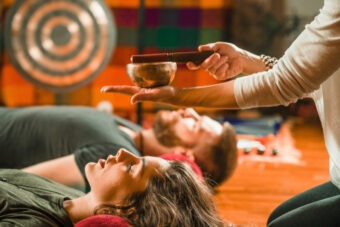Daily Mental Health Exercises That Will Change Your Life
Posted: May 13, 2024 | By: Shanon Peckham

If you’re dealing with anxiety, a major life change, burnout, a chronic health condition, or general day-to-day stress, it’s important to know that you have options for self-help and you are not alone. In 2023, The American Psychological Association reported Americans as a whole are still processing the collective trauma they experienced during the COVID-19 pandemic – and, so far, they’re doing it alone. As many as three in five adults may be downplaying how stressed they are to avoid burdening others, or because compared to others, they think their stress isn’t that bad or worth addressing.1 So, a lot of us feel like we are fighting this mental health battle alone, but it turns out that many people are going through the same thing at the same time. No one needs to struggle alone or feel powerless to change their circumstances. Everyone deserves healing and peace.
Culturally, we tend to talk about self-care as a fun sidebar to our day or week – an effortless period of relaxation and recharging brought on by an extra luxurious skincare routine, a soothing bath with a glass of wine, or watching your favorite movie with a pint of ice cream. But the real self-care, the kind that actually heals our inner wounds and helps us cultivate the best versions of ourselves, takes a lot more effort. It’s about time we recognize self-care for what it really is: constant, challenging emotional work that takes a lot of time and energy. To deny that is to stay on the aesthetic, surface level of self-care and ignore the deeper healing you could be benefitting from.
But where do we get started? How can we put in the work to find effective coping mechanisms and treatments when we’re already at our wit’s end? What happens if we can’t afford or access traditional therapies? The answer lies in effective self-care and self-help practices. We’ve done all the research for you, so all you need to do is keep reading.
Here are 5 therapist-approved, research-backed mental health exercises that can help you process or cope with difficult emotions, trauma, everyday stress, and more:
1 Guided Meditation & Relaxation Techniques
Guided meditation is a great tool to have available for stress management, whether you’re using it to center yourself in moments of peak emotion or as a nightly relaxation aid. Especially if you’re distressed, it can really help to have someone else tell you what to do. Studies show that meditation offers a variety of health benefits, including help with anxiety, depression, blood flow, cognitive function, the body’s nervous system stress responses, and so much more.2
There are many ways to access guided meditation, but the easiest way to incorporate it into your life may be through a free app, like PTSD Coach, Smiling Mind, Calm, or Insight Timer.
These relaxation exercises can help you calm your mind and body:3,4
- Grounding
- Gradual Muscle Relaxation or Body Scan
- Visualization
- Engaging with the 5 Senses
The goal of these exercises is to shift your body from “fight or flight” mode (sympathetic nervous system) to a “rest and digest” state of being (parasympathetic nervous system),5 which can help you calm down and be at peace in the present moment. Try one every day for a few weeks and see how you feel – you may be surprised how guided meditation helps you slow down and take your life one moment at a time.
2 Breathing Exercises
Breathing exercises are another easy, accessible way to promote relaxation and inner peace on challenging days. Like the grounding and visualization exercises, they can help you escape that “fight or flight” mode, with the added bonus of better lung health and circulation!
Here are some effective breathing exercises to try:
- Deep Breathing (AKA: Belly Breathing, Diaphragmic Breathing) – Experts say deep breathing may help regulate your heart rate, blood pressure, and even the oxygen levels in your lungs (making them more efficient).6,7
- Box Breathing (or Square Breathing) – This exercise can be especially useful for those who are coping with PTSD or anxiety disorders, due to its ability to help align body and mind at the same time quickly. It involves breathing in and out using consistent time intervals and has apparently been utilized by U.S. Navy Seals to cope with stress.8,9
- Alternate Nostril Breathing (Nadi Shodhan) & Humming Breathing (Bhramari) – These are used in conjunction with yoga (or guided meditation) to create a deep feeling of calm.10,11
Click here to view or print out instructions for these breathing exercises: Breathing Exercise Instructions
3 Mindfulness & CBT
Mindfulness techniques fall under the umbrella of Cognitive Behavioral Therapy (CBT), a psychological treatment that aims to help people unlearn unhelpful or harmful behaviors/ways of thinking and replace them with more effective coping strategies.12 CBT has been used to help address a variety of physical and mental health conditions, but has proven most helpful to those with PTSD, anxiety, and general stress.13
Some CBT activities you can try are:
- Journaling
- Though-Shifting Guided Meditation
- Core Beliefs Worksheet
- The Cognition Triangle Worksheet
You can easily access instructions for these activities through Google or an app like PTSD Coach.
Unlike the grounding exercises we discussed above, most of these involve more active thought and will require you to get in touch with your feelings. When done repeatedly and successfully integrated into your routine, these practices may help you confront your innermost traumas, reprogram your brain to cope better with stressors/triggers, let go of burdens more easily, and be able to navigate confidently through challenging emotions with better clarity.12 If you’re not feeling calm or safe enough to confront your feelings, we recommend starting with breathing exercises, movement, and journaling first.
4 Aromatherapy & Audio Therapy
An inner happy place is ideal for stress management on the go, but a comforting physical environment you can rely on is even better! In the same way that sights, sounds, and smells can trigger us into panic mode, they can also help us feel safe and at peace.
Spending time outdoors is a great way to access the many health benefits of nature. Get your vitamin D from the sun, enjoy some exercise, and soak up the soothing ambiance. Studies have shown that experiencing the sights, sounds, and smells of nature can lower stress levels and improve mood, among other positive effects.14,15,16
Online ASMR (Autonomous Sensory Meridian Response) can have a similar calming effect on people, in many cases helping them to achieve a state of deep relaxation, fall asleep, or manage anxiety symptoms. This type of audio typically involves quiet sounds that are created repeatedly, producing a soothing auditory experience for listeners. Physically, ASMR has been shown to lower heart rate, breathing rate, and pain levels; it may also boost dopamine and oxytocin levels, promoting a better mood.17,18 ASMR is often enjoyed via live stream, where viewers can directly request specific sounds for certain durations, but it can also be enjoyed through certain white noise apps and social media channels. We recommend searching for these terms on Google or your app store: ASMR, ambient music, white noise, sleep music, and nature sounds.
Aromatherapy is another great way to tap into the healing essence of nature at home. 100% pure essential oils are made from the steam distillation or cold pressing of plants, preserving their best qualities (including their scent) in liquid form. According to the experts, they may help with all kinds of issues, from general stress and anxiety, to chronic pain and skin conditions.16,19 Many, like Lavender, Frankincense, or Sandalwood, have natural sedative properties, perfect for diffusing or inhaling during moments of stress. You may also choose to mix your favorite essential oils into lotion or bath salts – just make sure to follow recommended dose amounts and always dilute them before using them directly on your skin.
5 Movement
Movement is great for physical and mental health! Daily exercise benefits the heart, brain, metabolism, immune system, mood and so much more.20 Especially if all else fails when you’re trying to relax or cope with triggers, we recommend trying some light exercise. “Even small amounts of physical activity can immediately reduce symptoms of anxiety in adults and older adults,” explained Dr. Paul Reed with the CDC.21 “Research suggests that increased physical activity, of any kind, can improve depression symptoms experienced by people across the lifespan.”
Sometimes, especially during the dreary, dark winter months, it can be hard to get motivated to get off the couch and exercise. Thankfully, there are plenty of ways to get your recommended 150 minutes of movement22 without spending all your spare time at the gym. We recommend using your 15-minute work breaks to walk daily, or using the extra hour of daylight to explore your local nature preserve on foot. Better still, here are some workouts for every experience level you can do from home (or anywhere).
If you have limited mobility, remember: you still have options! You can modify exercise routines as needed or ask for recommendations from a physical therapist. At the end of the day, any activity that engages the five senses can help calm your mind and body,3 enabling anyone to find peace through movement.
Follow up your new mental health routine with a new sleep routine! Keep reading: Build a Better Sleep Routine in 5 Easy Steps
Note: Though all of these exercises are well-researched and we believe they will help support you in your healing journey, please keep in mind that they may not work for everyone and are not a replacement for a doctor, licensed therapist, or live-saving medication. If your emotional distress symptoms are severe or worsen while trying these exercises, we always recommend contacting your healthcare professional or therapist. Don’t wait to seek help if you need it. If you are experiencing a mental health emergency, you can get the help you need by calling SAMHSA’s National Helpline at1-800-662-HELP (4357).
SOURCES
1 Stress in America 2023, American Psychological Association
2 Meditation: Process and effects, 2015
3 Grounding Exercises: Using Your 5 Senses for Anxiety Relief, 2021, Psych Central
6 Breathing Exercises, American Lung Association
8 What is box breathing?, 2023, Medical News Today
9 How To De-Stress In 5 Minutes Or Less, According To A Navy SEAL, 2019, Forbes
10 How and why to practice alternate nostril breathing, 2022, Medical News Today
11 This Simple Breath Practice is Scientifically Proven to Calm Your Mind, The Nomadic Yogi
12 What is Cognitive Behavioral Therapy?, American Psychological Association
13 The Efficacy of Cognitive Behavioral Therapy: A Review of Meta-analyses, 2012
14 Physiological Benefits of Viewing Nature: A Systematic Review of Indoor Experiments, 2019
15 A synthesis of health benefits of natural sounds and their distribution in national parks, 2021
17 Large portion of population may feel ASMR benefits, 2023, UCLA Health
18 ASMR for Sleep: How It Works and Triggers to Try, 2024, Sleep Foundation
19 Foundational Aromatherapy, 2nd Edition; Leiann King, Brenda Wright, & Amanda Reynolds
20 Benefits of Physical Activity, Centers for Disease Control and Prevention
22 How much physical activity do adults need?, Centers for Disease Control and Prevention
Posted in:






